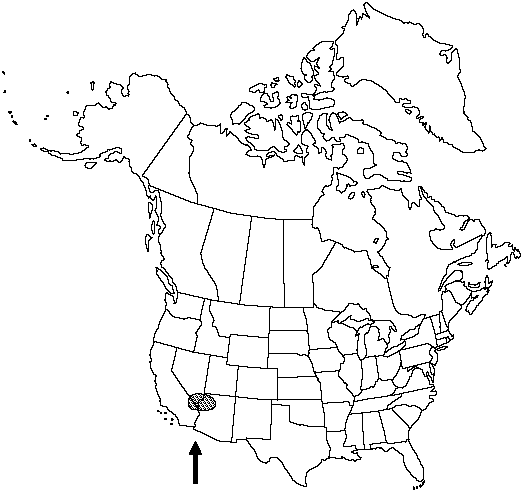Difference between revisions of "Selaginella leucobryoides"
Smithsonian Misc. Collect. 75: 8. 1920.
FNA>Volume Importer |
imported>Volume Importer |
||
| (7 intermediate revisions by 2 users not shown) | |||
| Line 8: | Line 8: | ||
}} | }} | ||
|common_names=Mojave spike-moss | |common_names=Mojave spike-moss | ||
| + | |special_status={{Treatment/ID/Special_status | ||
| + | |code=E | ||
| + | |label=Endemic | ||
| + | }} | ||
|basionyms= | |basionyms= | ||
|synonyms= | |synonyms= | ||
| Line 17: | Line 21: | ||
}}<!-- | }}<!-- | ||
| − | --><span class="statement" id="st- | + | --><span class="statement" id="st-undefined" data-properties=""><b>Plants </b>on rock, forming rounded cushionlike mats. <b>Stems</b> decumbent to short-creeping, dry stems readily fragmenting; irregularly forked, without budlike arrested branches, tips straight; main stem upperside and underside structurally slightly different, inconspicuously indeterminate, lateral branches radially symmetric, determinate, strongly ascending, 1-forked. <b>Rhizophores</b> borne on upperside of stems, throughout stem length, 0.2–0.35 mm diam. <b>Leaves</b> monomorphic, ± in alternate pseudowhorls of 4, tightly appressed, ascending, green, linear-oblong to linear-lanceolate, sometimes falcate on lateral rows (on main stem), 2–4.5 × 0.5–0.65 mm (usually smaller on young ascending branches); abaxial ridges present; base cuneate and decurrent (rounded and adnate on young branches), glabrous; margins short-ciliate, cilia transparent, scattered, spreading at base to ascending and dentiform toward apex, 0.07–0.15 mm; apex slightly attenuate and bristled or obtuse and abruptly bristled; bristle whitish or transparent, puberulent, 0.2–0.6 mm. <b>Strobili</b> solitary, 0.4–1.5 cm; sporophylls deltate-ovate or lanceolate, abaxial ridges moderately defined, base glabrous, margins short-ciliate to denticulate, apex acuminate with very short bristle.</span><!-- |
-->{{Treatment/Body | -->{{Treatment/Body | ||
| Line 23: | Line 27: | ||
|elevation=800–2800 m | |elevation=800–2800 m | ||
|distribution=Ariz.;Calif.;Nev. | |distribution=Ariz.;Calif.;Nev. | ||
| − | |discussion=<p>Selaginella leucobryoides has very tightly intertwined stems that readily fragment, a characteristic shared with S. utahensis and S. asprella. Selaginella leucobryoides is very closely related to, and difficult to separate from, S. utahensis (see discussion).</p> | + | |discussion=<p><i>Selaginella leucobryoides</i> has very tightly intertwined stems that readily fragment, a characteristic shared with <i>S. utahensis</i> and <i>S. asprella</i>. <i>Selaginella leucobryoides</i> is very closely related to, and difficult to separate from, <i>S. utahensis</i> (see discussion).</p> |
|tables= | |tables= | ||
|references= | |references= | ||
| Line 32: | Line 36: | ||
-->{{#Taxon: | -->{{#Taxon: | ||
name=Selaginella leucobryoides | name=Selaginella leucobryoides | ||
| − | |||
|authority=Maxon | |authority=Maxon | ||
|rank=species | |rank=species | ||
| Line 45: | Line 48: | ||
|publication title=Smithsonian Misc. Collect. | |publication title=Smithsonian Misc. Collect. | ||
|publication year=1920 | |publication year=1920 | ||
| − | |special status= | + | |special status=Endemic |
| − | |source xml=https:// | + | |source xml=https://bitbucket.org/aafc-mbb/fna-data-curation/src/2e0870ddd59836b60bcf96646a41e87ea5a5943a/coarse_grained_fna_xml/V2/V2_750.xml |
|genus=Selaginella | |genus=Selaginella | ||
|subgenus=Selaginella subg. Tetragonostachys | |subgenus=Selaginella subg. Tetragonostachys | ||
|species=Selaginella leucobryoides | |species=Selaginella leucobryoides | ||
| − | |||
| − | |||
| − | |||
| − | |||
| − | |||
| − | |||
| − | |||
| − | |||
| − | |||
| − | |||
| − | |||
| − | |||
| − | |||
| − | |||
| − | |||
| − | |||
| − | |||
| − | |||
| − | |||
| − | |||
| − | |||
| − | |||
| − | |||
| − | |||
| − | |||
| − | |||
| − | |||
| − | |||
| − | |||
| − | |||
| − | |||
| − | |||
| − | |||
| − | |||
| − | |||
| − | |||
| − | |||
| − | |||
| − | |||
| − | |||
| − | |||
}}<!-- | }}<!-- | ||
-->[[Category:Treatment]][[Category:Selaginella subg. Tetragonostachys]] | -->[[Category:Treatment]][[Category:Selaginella subg. Tetragonostachys]] | ||
Latest revision as of 21:25, 5 November 2020
Plants on rock, forming rounded cushionlike mats. Stems decumbent to short-creeping, dry stems readily fragmenting; irregularly forked, without budlike arrested branches, tips straight; main stem upperside and underside structurally slightly different, inconspicuously indeterminate, lateral branches radially symmetric, determinate, strongly ascending, 1-forked. Rhizophores borne on upperside of stems, throughout stem length, 0.2–0.35 mm diam. Leaves monomorphic, ± in alternate pseudowhorls of 4, tightly appressed, ascending, green, linear-oblong to linear-lanceolate, sometimes falcate on lateral rows (on main stem), 2–4.5 × 0.5–0.65 mm (usually smaller on young ascending branches); abaxial ridges present; base cuneate and decurrent (rounded and adnate on young branches), glabrous; margins short-ciliate, cilia transparent, scattered, spreading at base to ascending and dentiform toward apex, 0.07–0.15 mm; apex slightly attenuate and bristled or obtuse and abruptly bristled; bristle whitish or transparent, puberulent, 0.2–0.6 mm. Strobili solitary, 0.4–1.5 cm; sporophylls deltate-ovate or lanceolate, abaxial ridges moderately defined, base glabrous, margins short-ciliate to denticulate, apex acuminate with very short bristle.
Habitat: In rock crevices or on exposed rock
Elevation: 800–2800 m
Distribution

Ariz., Calif., Nev.
Discussion
Selaginella leucobryoides has very tightly intertwined stems that readily fragment, a characteristic shared with S. utahensis and S. asprella. Selaginella leucobryoides is very closely related to, and difficult to separate from, S. utahensis (see discussion).
Selected References
None.